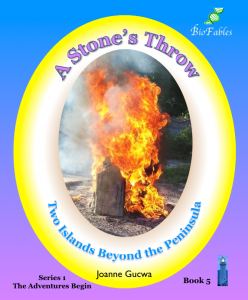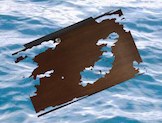
 To most people, Wisconsin’s Door County doesn’t go beyond the peninsula. Did you know, though, that the Door in Door County comes from the narrow water passage called Death’s Door? Grandpa Mike explains how the open waters of Lake Michigan to the east and Green Bay to the west crash into each other here. Stormy weather makes this stretch of water particularly dangerous. Seven-year-old Mallory searches in vain for a floating door in the water as the ferry makes its way to Washington Island. His twin sister Melody is more interested in islands.
To most people, Wisconsin’s Door County doesn’t go beyond the peninsula. Did you know, though, that the Door in Door County comes from the narrow water passage called Death’s Door? Grandpa Mike explains how the open waters of Lake Michigan to the east and Green Bay to the west crash into each other here. Stormy weather makes this stretch of water particularly dangerous. Seven-year-old Mallory searches in vain for a floating door in the water as the ferry makes its way to Washington Island. His twin sister Melody is more interested in islands.
BioFables children’s books focus on illuminating Sciences (STEM: Science, Technology, Engineering, Math) principles through fun stories. Parents, you know from experience that learning the subject matter that we call Sciences is a good first step. Understanding Humanities subjects helps us know how best to apply Sciences principles to the practical needs of the external world. And understanding one’s internal Values/Behaviors helps us to make things happen.
Every BioFables book weaves lessons derived from these interconnected (and often hidden) core disciplines into realistic stories that children relate to. Parents, you can use the free resources of this site to uncover those nearly-invisible lessons. They will help you prepare your children for happy, productive, rewarding and well-balanced lives.
If you’re ready to purchase A Stone’s Throw, please click on the Buy A Stone’s Throw icon to go directly to Barnes and Nobles’ A Stone’s Throw page. Your purchase of A Stone’s Throw helps support our ongoing efforts to continue expanding the wealth of this site’s free resources for homeschooling and all parents who are dedicated to the intellectual growth of their children.
If you’d like to learn more about using the considerable A Stone’s Throw resources at this site, please read on.
A Stone’s Throw Resources
The ten chapters in A Stone’s Throw contain nearly a hundred practical mini-lessons and pop-up lessons woven throughout A Stone’s Throw. We call these practical lessons Knowledge Nuggets. These Knowledge Nuggets contain specific information that readers can apply to their everyday lives. They may be in the form of a mini-lesson, with simple explanations of a specific concept, or as a quick, unplanned pop-up lesson.
Four sets of tables and lists in the A Stone’s Throw Knowledge Gateways page help you to place a given Knowledge Nugget within the greater realm of learning.
-
- Chapter-by-Chapter: Sciences, Humanities, Values/Behaviors
- Entire A Stone’s Throw: Sciences topics
- Entire A Stone’s Throw: Humanities topics
- Entire A Stone’s Throw: Values/Behaviors topics
Please visit Site Tips for even more ways to mine the wealth of information available on this site.

